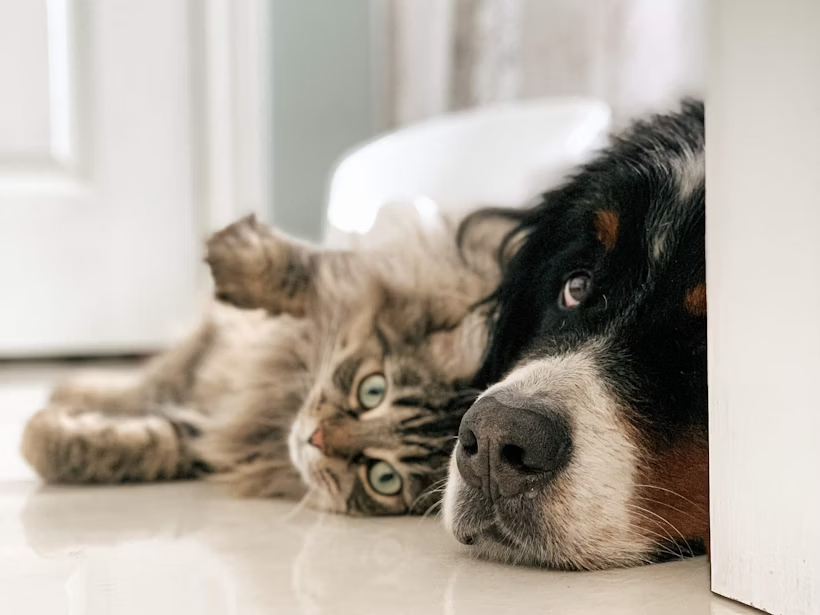Dogs can hear more than we can. Not just better, but actually more. They detect a wider range of frequencies and can pick up on sounds from much farther away. And our feline friends? Well, their hearing is even more impressive.
With such sensitive ears, it’s no surprise that neither dogs nor cats are particularly fond of loud sounds. In fact, some pets experience extreme fear—and may respond with destructive or unpredictable behavior—during noisy events, such as storms or firework displays. More common sounds, including those from cars, construction, and neighbors, can also be alarming or stressful to pets.
If not addressed early (and through ongoing exposure), a sound-averse pet’s fear may generalize, causing them to react to even lesser sounds. Fortunately, you can teach your pets to better tolerate big bangs, booms, clatters, and other noises. And the following three strategies—often used together—can help.

Environmental management: Create a safe space away from the noise.
Your pet’s instinctual response to scary sounds will likely be to retreat to somewhere comforting and safe. So, it’s important to make sure they have such a space.
You’ll want to opt for a den-like environment—an interior room with soft bedding, favorite toys, and few or no windows. Also, be sure your pet has access to water and that you leave the lights on. Consider playing classical music, as well, which may help soothe their anxiety and drown out some of the unsettling noise.
Did you know? Dogs and cats can develop phobias at any stage of life. So, even if yours don’t seem to mind noises now, you might need these tips down the road.
Create this safe haven in advance of any anticipated loud events so your pet can get accustomed to it and already view it as a relaxing place. But keep in mind that if they instead choose their own hideout—whether it’s their crate or under your bed—leave them be. Trying to force your pet somewhere else will likely make the whole experience more traumatic for them.
One last thing (and probably the hardest): Avoid showing your pets excess attention or giving other “rewards” when they’re acting overly fearful. Though well-intended, such a response could reinforce their negative reaction to loud sounds.

Behavioral modification: Countercondition and desensitize to make bad stimuli better.
Much like socialization, counterconditioning and desensitization are powerful tools for behavior modification.
The concept of counterconditioning is a simple one: Change your pet’s emotional response to a bad thing (a loud noise, in this instance) by associating it with a good thing (often some kind of special treat).
Desensitization, on the other hand, is the process of exposing your pet to their negative trigger in gradually increasing amounts to normalize it. When done properly, this can significantly decrease negative responses to the trigger—even at high levels of exposure.
Did you know? Dogs and cats can sense changes in barometric pressure during storms. So, even if you desensitize your pet to the sound of thunder, you might find they still react to storms.
In theory, you can practice counterconditioning during any loud event. But it’s most effective when combined with desensitization. In the ideal scenario, a negative stimulus is present but not above your pet’s stress threshold. Once a dog or cat reaches a certain level of fear, they’re unlikely to care about whatever you’re using as the counterconditioning reward.
To give your pet time to learn and adapt, start the following process weeks in advance of a challenging event, such as the 4th of July.
- Find an audio recording of the sound you want your pet to become accustomed to. There are sound desensitization CDs and DVDs that you can buy. But free clips of common scary sounds, such as fireworks and thunder, also exist online. (Keep in mind that the better quality your audio device is, the more realistic the sound—and more successful the desensitization—will be.)
- When your pet is relaxed or engaged in a positive activity (e.g., eating, playing), start the recording with the volume set so low that you can barely hear it. If your pet shows signs of fear (such as hiding, trembling, cowering, panting, and so on), it’s too loud. What you’re going for is a volume that causes no reaction whatsoever—while still being within their range of hearing.
- Over the course of several weeks, play the sound for 30+ minutes at a time, slightly increasing the volume each session. And be sure to expose your pet to the recording in various settings (e.g., different rooms, in the car, outside) so they learn to think of the noise as commonplace. Again, if your pet responds negatively at any point, reduce the volume until they’re comfortable.
Lastly, take care to never scold or punish your dog or cat for reacting to loud sounds, as this will only make their fear worse.

Supportive medications: Provide short-term relief from stressful events.
For truly noise-averse pets, veterinarians often prescribe anxiolytic (i.e., anxiety-reducing) medication, such as Sileo or Xanax, prior to predictable loud events. If you think your pet may benefit from such treatment, check in with your veterinarian well before any expected noisy experience to ensure you’re able to get what you need in time.
Did you know? When multiple loud noises occur at once (e.g., a truck backfiring as a car alarm goes off), they may combine to worsen a pet’s fear or other negative response. This is called “trigger stacking.”
Here are a few other ways to put your pet at ease that don’t require a prescription:
- You can spray calming pheromones (such as Adaptil for dogs or Feliway for cats) on your pet’s collar or bed or spread them throughout your house via diffusers. Such products often mimic the pheromones produced by nursing female dogs and cats—giving pets a sense of safety.
- For sound-sensitive dogs, a few drops of lavender essential oil in the corner of their blanket may help calm them. But this is best for households without feline friends, as cats don’t find the smell quite as favorable.
- Nutraceuticals—including Anxitane (L-theanine), L-tryptophan products, and Zylkene (a milk protein supplement)—can also support relaxation in pets. But they’re best for unpredictable noise events (think: summer thunderstorms vs. Independence Day celebrations) and long-term anxiety issues.
- A ThunderShirt, anxiety wrap, or other calming apparel may comfort some pets during loud events by providing even pressure over the torso (similar to the way weighted blankets help reduce anxiety in people). But they can also have the opposite effect if your dog or cat isn’t used to wearing clothes.
- In many cases, a lack of exercise contributes to anxious behavior—especially in dogs. So, make sure your pup gets their daily dose of activity.
- As mentioned above, playing music may relax your pets or help drown out the scary noise. Dogs appear to enjoy reggae, classical, and soft rock. But every pet’s musical taste is a little different.
Learn more about personalizing your pet’s care.
We hope these tips help your dog and/or cat have a fear-free season of sound. Want to understand their unique needs even better? Decode their ancestry, traits, and health risks so you can care smarter.
Explore Pet DNA Tests